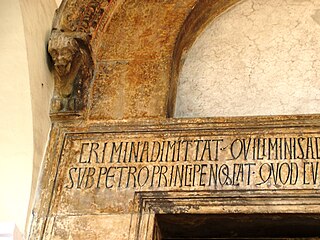
Year 1011 (MXI) was a common year starting on Monday of the Julian Calendar.

Gaeta is a city and comune in the province of Latina, in Lazio, central Italy. Set on a promontory stretching towards the Gulf of Gaeta, it is 120 kilometres from Rome and 80 km (50 mi) from Naples.

Sikelgaita was a Lombard princess, the daughter of Guaimar IV, Prince of Salerno, and second wife of Robert Guiscard, Duke of Apulia. She commanded troops in her own right.

Guaimar IV was Prince of Salerno (1027–1052), Duke of Amalfi (1039–1052), Duke of Gaeta (1040–1041), and Prince of Capua (1038–1047) in Southern Italy over the period from 1027 to 1052. He was an important figure in the final phase of Byzantine authority in the Mezzogiorno and the commencement of Norman power. He was, according to Amatus of Montecassino, "more courageous than his father, more generous and more courteous; indeed he possessed all the qualities a layman should have—except that he took an excessive delight in women."

The Duchy of Gaeta was an early medieval state centered on the coastal South Italian city of Gaeta. It began in the early ninth century as the local community began to grow autonomous as Byzantine power lagged in the Mediterranean and the peninsula due to Lombard and Saracen incursions.

John I was the second hypatos of Gaeta of his dynasty, a son of Dociblis I and Matrona, and perhaps the greatest of medieval Gaetan rulers.
Alberic I was the Lombard Duke of Spoleto from between 896 and 900 until 920, 922, or thereabouts. He was also Margrave of Camerino, and the son-in-law of Theophylact I, Count of Tusculum, the most powerful man in Rome.
Richard III, also known as Richard of Caleno, was the Norman count of Carinola and last quasi-independent Duke of Gaeta, ruling from 1121 to his death. From 1113, he was regent of Gaeta for his cousin or nephew, Duke Jonathan; in 1121 he succeeded him. As duke he was a nominal vassal of the Princes of Capua, to whom he was related.
Leo I, sometimes called the Usurper, was the regent of the Duchy of Gaeta from 1017 until 1024. He was a younger son of Duke John III and Duchess Emilia. After the death of his brother, John IV in 1008, his mother took over the regency for her grandson, Leo's nephew, John V. Leo challenged his mother for the regency, successfully displacing her by 1017.
Atenulf I was the Lombard count of Aquino who rose to become Duke of Gaeta in Southern Italy during the chaotic middle of the eleventh century.

The Norman conquest of southern Italy, also known as The Kingdom In The Sun, lasted from 999 to 1139, involving many battles and independent conquerors.
Gregory was the Duke of Gaeta from 963 until his death. He was the second son of Docibilis II of Gaeta and his wife Orania. He succeeded his brother John II, who had left only daughters. Gregory rapidly depleted the publicum of the Duchy of Gaeta by doling it out to family members as grants. Gregory disappears from the records in 964 and was succeeded by his younger brother Marinus of Fondi over the heads of his three sons. It is possible that there was an internal power struggle between factions of the Docibilan family and that Gregory was forced out. On the other hand, perhaps he died and his sons fought a losing battle for their inheritance to Gaeta.
Jonathan, a member of a cadet branch of the Drengot family, was the Duke of Gaeta from 1113 until his death. He is known from the Codex Caietanus to have been in the fourth year of his minority in 1116 and the seventh of his rule in 1119. There are three theories of his paternity. He may have been the son of Count Jonathan I of Carinola or his grandson by an unnamed son, or else the grandson of Count Bartholomew of Carinola. He was under the regency of his cousin or uncle, Count Richard of Carinola.
Gualganus, surnamed Ridel, was the third and last Count of Pontecorvo and Duke of Gaeta of the Norman Ridel family from about 1091 until about 1103. He was a son and successor of Duke Raynald Ridel, but his rule in Gaeta was not unopposed.
Hugh was the Count of Suio in the Duchy of Gaeta. He was probably a son of Docibilis magnificus, who in turn was probably a son of Landolf, son of Gregory, Duke of Gaeta, and Landolf's mistress Polyssena (Pulessene). He was a brother of Duke Leo II of Gaeta.
Andrew was the Duke of Gaeta from 1111 until his death in 1113. He succeeded his father, Duke Richard II, upon the latter's death. He left no heir at his own death and his duchy escheated to Prince Robert I of Capua, his suzerain. His successor, Jonathan, was in power by May 1113.
Ranulf I was the count of Caiazzo in the Principality of Capua from about 1078. He also brought the formerly Lombard counties of Alife, Telese and Sant'Agata dei Goti and the castles of Airola and Tocco Caudio under his control, dominating the region between Capua and Benevento. He passed this territorial lordship on intact to his heirs, and it remained in their possession until the death of his grandson and namesake, Ranulf II, in 1139.

Robert was a south Italian nobleman who ruled the counties of Airola, Alife, Caiazzo, Sant'Agata and Telese from 1088 until his death. He was the regent of Capua in 1090–93, and was effectively independent of any lord after 1105. He was a major patron of churches and abbeys, and also commissioned several books.
Atenulf was the Abbot of Montecassino from 1011 until his death. He was a cousin of Prince Pandulf II of Capua, a younger son of Prince Pandulf III and brother of Prince Pandulf IV.